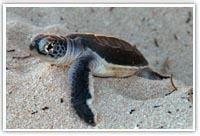
Marine Turtles in the RSGA Waters:
Overview
Marine turtles are some of the oldest surviving reptiles on the planet, and have inhabited the tropical seas and oceans for millions of years. Turtles are irreplaceable ecological resources in that they function as key individuals in a number of habitats, and can play the role of indicator species for the relative health of their surroundings. Turtle habitats support important populations of commercial fish and invertebrates (seagrass beds, open oceans and coral reefs, among others). For these reasons, turtles often act as flagship species for conservation programmes, mainly because their conservation demands the protection of vast and diverse marine areas in order to provide for all biological processes of the turtle's lifecycle.
More recently, however, human actions have brought many populations to the brink of extinction either through direct consumption or a consequence of unsound activities. All species of marine turtle have consequently been classified as endangered and are listed by CITES in Appendix I.
The RSGA region supports globally important feeding and nesting grounds for populations of green, hawksbill and loggerhead turtles in particular. Turtles are migratory; they may swim considerable distances from their feeding grounds to their nesting beaches. Recent nesting surveys carried out in Djibouti by PERSGA have discovered a migratory route from as far away as Sri Lanka. As such, it is evident that turtle conservation requires international cooperation to be successful, both between countries and between regions.
Threats and Issues:
Throughout the southern Red Sea and Gulf of Aden, turtles are caught either accidentally as by-catch or intentionally by fishermen. Turtle oil, meat, and eggs are eaten, and the shells are sold to tourists. Capture of turtles, together with egg collection and disturbance or destruction of nesting sites and nesting beaches, has resulted in a decline in nesting populations. In areas with poor finfish resources, fishermen often depend on turtles for subsidiary food. Stray dogs that feed on turtle eggs and hatchlings aggravate the problem in some areas.
Additionally, nesting turtles are threatened by light coming from nearby urban areas, coastal roads and highways. Excessive light prevents pregnant turtles from nesting (often meaning they lay their eggs at sea), and it also has a distortion effect on the navigation system of newly hatched turtles, meaning they are unable to make thier way to ocean.
Monitoring Activities:
Turtle surveys have been conducted within the region, executed by regional specialists trained through the SAP, in order to evaluate the present status of these key species and prepare the groundwork for conservation plans. Survey work has taken place in Djibouti, Egypt, Saudi Arabia, Sudan, and Yemen during 2002 and 2003, and turtle kits with tags were distributed to the five countries.
These surveys have provided a substantial body of data for national inventories, against which future data can be compared to detect and measure changes that might be occurring due to natural or human interference. Furthermore, the information collected has enabled PERSGA to develop a detailed report on the status of marine turtles in the region:
Standardized Survey Methods:
PERSGA has developed a regionally-applicable and scientifically robust Standardized Survey Methodology to facilitate its monitoring of key species and habitats in the region. PERSGA compiles all data collected for its science, research and monitoring activities into a comprehensive GIS database.
Standard Survey Methods for Key Species in the Red Sea and Gulf of Aden (PERSGA Technical Series No. 10)
As of 2001, PERSGA has conducted a series of training courses to teach specific survey methods. The training courses was also used as tools to evaluate the methods and to determine their applicability to the region.
As a consequence of the training carried out by PERSGA, all the countries of the region are now able to carry out their own biodiversity and habitat studies, prepare species lists and monitor environmental changes.
Conservation Actions:
Following the survey work and training activities, PERSGA's next step was the development of a Regional Action Plan (RAP) for the Conservation of Marine Turtles in the Red Sea and Gulf of Aden.
The Regional Action Plan addresses the primary causes of turtle mortality with a series of proposed actions. These actions include: identifying the populations most at risk; reducing threats to turtle populations from commercial fisheries, land development operations, and human interference; implementing programmes that provide alternatives to communities dependent on turtle populations for their survival or livelihood; regulating direct capture and trade in turtles; developing nesting beach programmes to maximize hatchling recruitment; and promoting turtle rescue and rehabilitation along with public awareness activities.
In addition to the Regional Action Plan, PERSGA has also worked with its individual Member States to furnish National Action Plans relating to the conservation of marine turtles